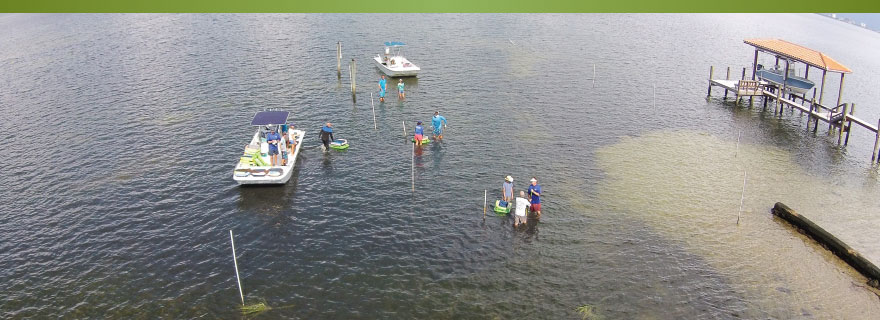
“We haven’t found anything that works any better, so we keep using them,” says Peter Clark, executive director of Tampa Bay Watch.
Over the past eight years, Tampa Bay Watch has transplanted four sets of seagrasses from a donor site near the old Westinghouse plant to protected areas off MacDill Air Force Base, where boat traffic is strictly limited. “The first plantings were made at different depths so we could determine which location was best,” Clark said.
Those original plantings grew from about 500 square feet to more than 14,000 square feet in a little more than two years.
That long-term success made Tampa Bay Watch the logical choice when the city of Tampa needed help transplanting seagrasses that had naturally recruited into a shoaled entrance channel outside a canal in the Westshore area.
Originally dredged in the 1960s, the finger canals had collected silt from stormwater for decades and had become difficult to navigate. At the same time, water quality in the area had improved enough that seagrasses were growing back at the edge of a channel leading to the bay.
“With the channel silting in, boaters were cutting across nearby seagrass beds and leaving scars,” said Heather Maggio of the city of Tampa’s stormwater department. “Moving these seagrasses will allow us to dredge the channel, protect existing seagrasses and actually expand seagrass coverage in the bay.”
Approximately 938 meters — about 10,000 square feet — of seagrasses were dug up in two-square-foot sections then transplanted in a grid pattern that covers 20,000 square feet. Tampa Bay Watch staff dug the seagrass “plugs” with sediment attached, then volunteers transported them 300 yards southwest of the original site to be transplanted.
“The new site is in deeper water and further away from the channel so it won’t be impacted by boat traffic,” Maggio said.
Ongoing monitoring through 2016 will track the growth of the seagrasses with full recovery expected in two years.
[su_note note_color=”#4094ad” text_color=”#ffffff”]Researchers focus on long-term success of seagrass mitigation
In most human endeavors, it’s pretty easy to tell what worked and what didn’t. It’s more challenging with ecosystem restorations – and even more difficult with underwater restoration.
Although seagrass mitigation and restoration has been ongoing in Florida since the 1970s, very little work has been done to track the long-term success of individual projects, says Penny Hall, a research scientist with the Florida Fish and Wildlife Institute in St. Petersburg.
“Prior to about 2000, when applications could be filed online, we have a lot of information but no real idea – or even a ballpark estimate – on how much mitigation was permitted or how many of those projects actually worked,” she said.
Over the last two years, Hall and an attorney who once worked for the National Oceanic and Atmospheric Administration traversed the state, digging through microfiche papers to identify permits. “We now have a giant database with a lot of holes – some permits from the DEP (Florida Department of Environmental Protection) and some permits from the U.S. Army Corps (of Engineers) but very little follow-through,” she said.
The next step is reaching out to the people who have been involved in the projects, including consultants and agency staff, including those who may have already retired. “It’s really going to become a personal initiative, sitting down and talking with people to find out what they know,” she said.
Once more of the questions in her database have been answered, Hall plans to write a grant for funding to visit several of the sites to ground-truth results of the long-ago restorations.
“Even some of the projects we’ve done in the last 10 to 12 years can’t be considered ‘complete,’ because we may have used shallow-rooted Halodule to plant around the edges of a bare spot that had been covered with turtle grass. It can take years and years for the turtle grass to grow in, and it’s not really restored until it’s what had been there before.”
Long-term monitoring is critical with seagrasses because not all species are created equal, she adds. Halodule – or shoal grass – is considered to be an ephemeral species that is the first to colonize bay bottom but is much more likely to be damaged if heavy rains increase nutrient loadings. [su_button url=”http://baysoundings.com/legacy-archives/summer09/Stories/feature.php” target=”blank” style=”flat” background=”#465f7c” radius=”0″ ts_color=”light”]See article from our Summer 2009 issue.[/su_button]
And initiatives that work well in one place don’t always work in another, Hall notes. “One of the things that started me on this project was bird stakes popping up all over the state.”
The bird stakes, which encourage birds to visit sites with heavy scarring or where seagrasses are being restored, add nitrogen to the water when the birds defecate, she explains. In the Florida Keys, where the water is typically nutrient poor, the extra nitrogen has helped fuel the growth of seagrasses. In places like Indian River Lagoon, where nutrient levels already are high, they won’t help and may actually damage seagrasses below them.
“We need to have an idea of what works where and why so that going forward we can take advantage of that knowledge,” she said.[/su_note] [su_divider]
